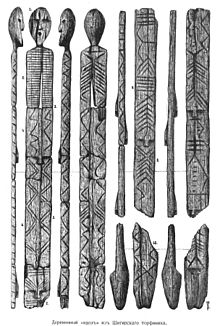Wooden idol from the Shigir moor
The wooden idol from the Shigir moor is an ornate pole, which was probably erected as an anthropomorphic pole deity . The figure was discovered in January 1890 at a depth of four meters in a peat cut near the village of Kalata near Kirovgrad , north of Yekaterinburg , in Russia . According to initial investigations using the radiocarbon method in 2015, the wooden stake was initially sunk around 9000 BC. To date. In later systematic radiocarbon dating, the age of the figure was set to 9500 BC. Estimated. This makes it the oldest wooden sculpture in the world. The corresponding research results of a German-Russian research team with the participation of the University of Göttingen were scientifically published for the first time in 2018.
description
Originally probably five meters high and now 3.8 meters high, it is made of larch wood and is a testimony to Mesolithic wood carving and a monumental art unknown in western Europe. Scientists believe that the sculpture stood upright for a long time and served as a ritual stake. The piece shows that the importance of Eastern Europe for the Stone Age development of Eurasia was underestimated. In Schigir Moor were discovered antler and bones over 3,000 hunting guns, fishing equipment and tools.
In 2000, Yuri Serikow postulated that the deserted region was only around 7400 BC. Was repopulated by a transural culture. The date of the wooden idol and the date of around 8500 BC speak against this. BC dated bony. Arrowheads and spears with flint cutting from the Lobvinskaya Cave .
An interdisciplinary working group has set itself the goal of using wet soil archeology to obtain data on the development of the post-ice age (around 9500-5000 BC) in the Central Transural and to work out a cultural sequence. It is about when the first pottery appeared in the Urals . The round-bottomed, sometimes richly decorated, early hunter ceramics defined the beginning of the so-called forest neolithic , in which ceramics were produced as hunters and gatherers continued to live without arable farming or livestock farming. In the end, the Forest Neolithic radiated with the Ertebölle culture to southern Scandinavia, northern Germany , and the Netherlands ( Swifterbant culture ).
See also
literature
- Sönke Hartz, Svetlana Savchenko, Thomas Terberger , Mikhail Zhilin: Elk hunters and beaver trappers. Hunters and fishermen in the Transural 10,000 years ago. In: Archeology in Germany , year 2010, no. 5, p. 58 ff. ( Online )
- Mikhail Zhilin, Svetlana Savchenko, Svend Hansen , Karl-Uwe Heussner, Thomas Terberger: Early art in the Urals: new research on the wooden sculpture from Shigir. in Antiquity , 92 (362): 334–350, 2018 ( doi : 10.15184 / aqy.2018.48 )
Web links
- Kate Baklitskaya: Scientists to study the exact age of 'oldest wooden statue in the world'. In: The Siberian Times, June 25, 2014
- Researchers at the University of Göttingen: Early post-ice hunters were also wood artists at HNA on May 2, 2018
- Oldest wooden sculpture in the world discovered at scinexx on May 2nd, 2018
- The miraculous man from the moor in Spiegel Online from May 2, 2018
Individual evidence
- ↑ Anna Liesowska: Revelations on Shigir Idol 'change our understanding of ancient civilizations' in the Siberian Times, August 28, 2015. Accessed August 30, 2015.
- ↑ Spiegel Online: Find in the Shigir moor: Russian wooden sculpture is 11,000 years old from August 31, 2015
- ↑ Romas Bielke: The world's oldest wooden sculpture is 11,500 years old , press release from the University of Göttingen on April 30, 2018
Coordinates: 57 ° 22 ′ 51.2 ″ N , 60 ° 8 ′ 26.5 ″ E

